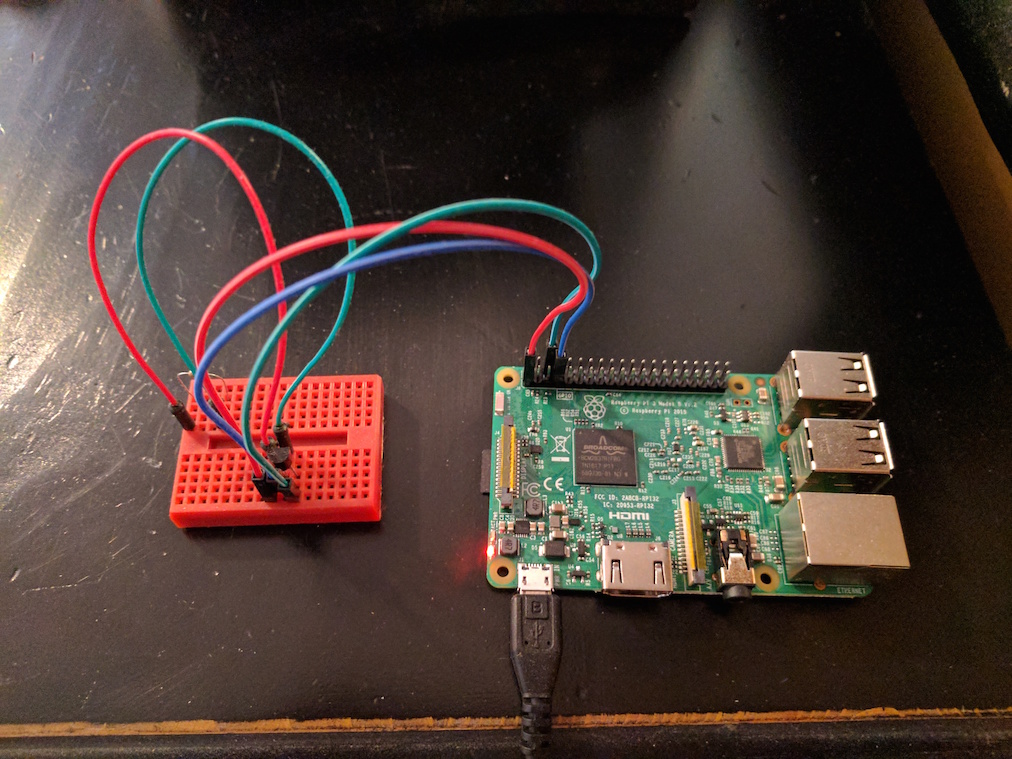Thermometer Readings with Raspberry Pi
Okay so as part of my Raspberry Pi Thermostat Project I now have a headless Raspberry Pi that I can SSH into. The next small step is to wire a thermometer to it and begin logging the temperature in my bedroom to learn a thing or two about how hot it is getting up there and how much the temperature varies.
Hardware involved:
- The headless Raspberry Pi I set up in the previous post
- A DS18B20 digital thermometer
- A small breadboard
- Some male-to-female jumper wires
- A 10kΩ resistor
Wiring
For this part I basically just followed this tutorial but with a couple small changes. I used a 10kΩ instead of a 4.7kΩ because it’s what I had around. I also didn’t shell out for the Pi Cobbler. I simply connected the three lines I needed (5V, ground, GPIO 4) directly to the breadboard with jumper wires. I still found the wiring diagram here to be incredibly useful. Mine ended up looking like this:

Making a temperature reading
Once it’s all wired up there are a couple simple steps to reading the temperature. First I had to edit /boot/config.txt and add this line and then reboot:
dtoverlay=w1-gpio
This enables the Onewire interface that we use to read the thermometer. Next, run the following commands to mount the thermometer device:
sudo modprobe w1_gpio
sudo modprobe w1_therm
The thermometer is now ready to be read. All you have to do is find the right file to read from. To do this, go to /sys/bus/w1/devices and look for a folder that starts with 28- followed by a serial number. Copy this serial number because you will need it. If you now do cat /sys/bus/w1/devices/28-{SERIAL NUMBER}/w1_slave you will get something that looks like this:
79 01 55 00 7f ff 0c 10 14 : crc=14 YES
79 01 55 00 7f ff 0c 10 14 t=23562
The YES indicates that the temperature reading was successful. The t=23562 is the temperature in Celsius multiplied by 1000. Now we’re in business.
Reading the temperature with Ruby
I wanted to track and log the temperature in my bedroom so the easiest thing to do was write a little ruby script that I would run on a cron. I installed Ruby using RVM and wrote the following module to simply read the temperature and convert it to Fahrenheit so my American brain can understand it.
Logging the temperature
The last step of this bit was creating a ruby script that would use that thermometer module and spit out a timestamp and the temperature. It looks a little something like this:
All that was left to do was set that script up in a cron job with the output going to a file and I now I have a file that looks like this:
2017-06-07 01:57 > 74.1866
2017-06-07 01:58 > 74.30000000000001
2017-06-07 01:59 > 74.525
2017-06-07 02:00 > 74.6366
2017-06-07 02:01 > 74.86160000000001
2017-06-07 02:02 > 74.975
2017-06-07 02:03 > 75.0866